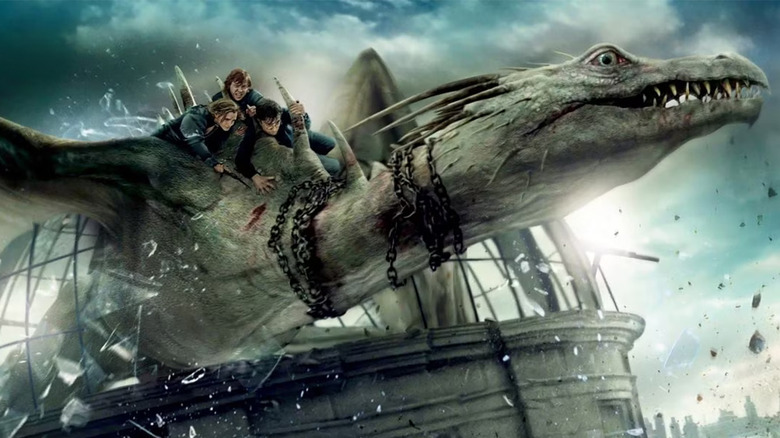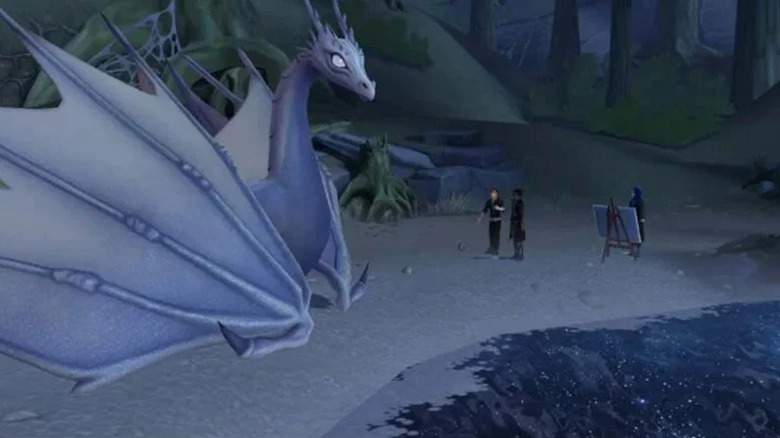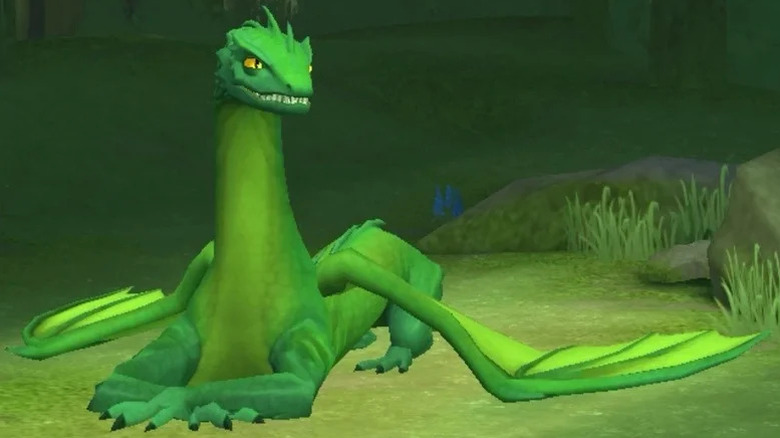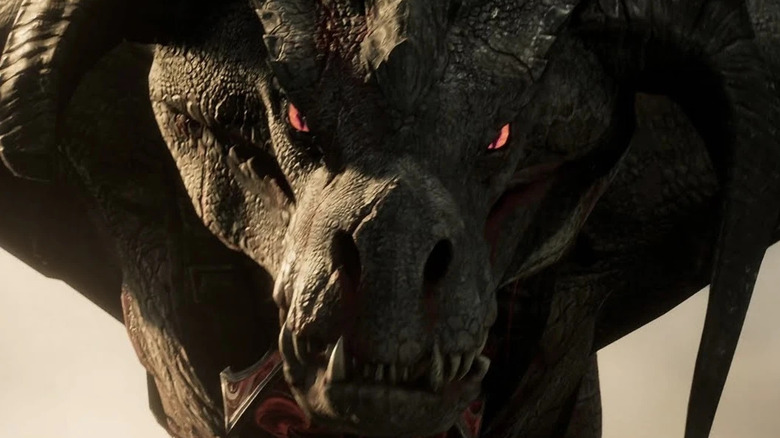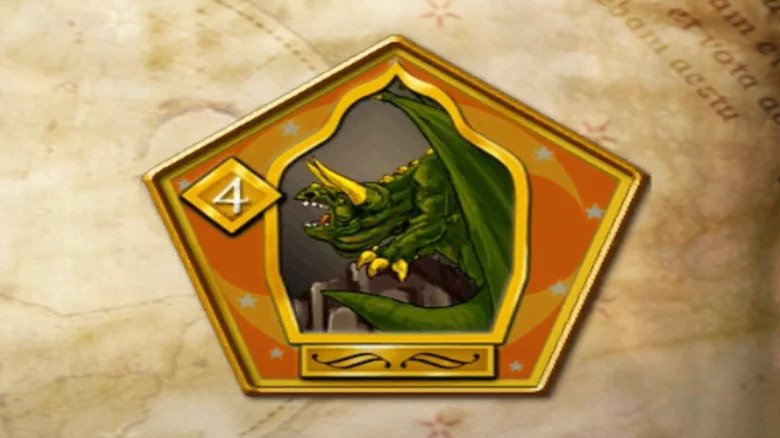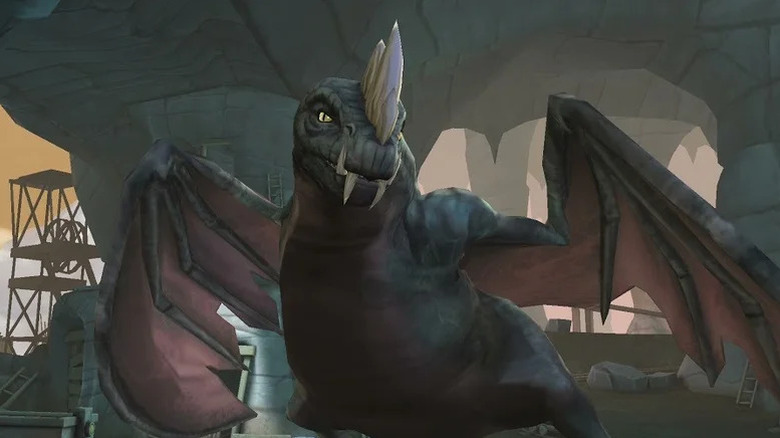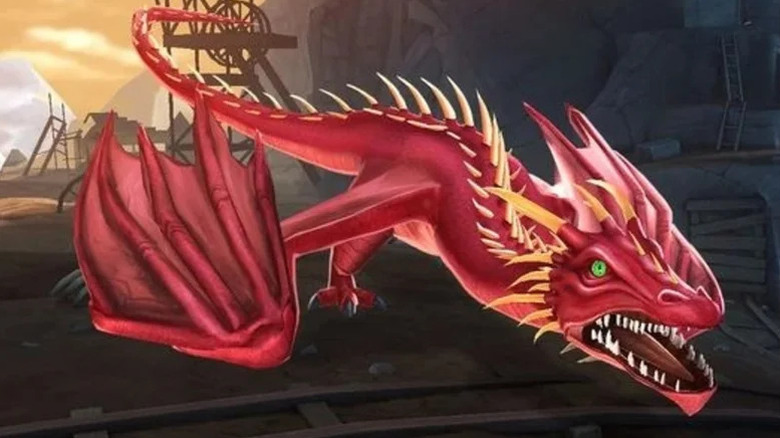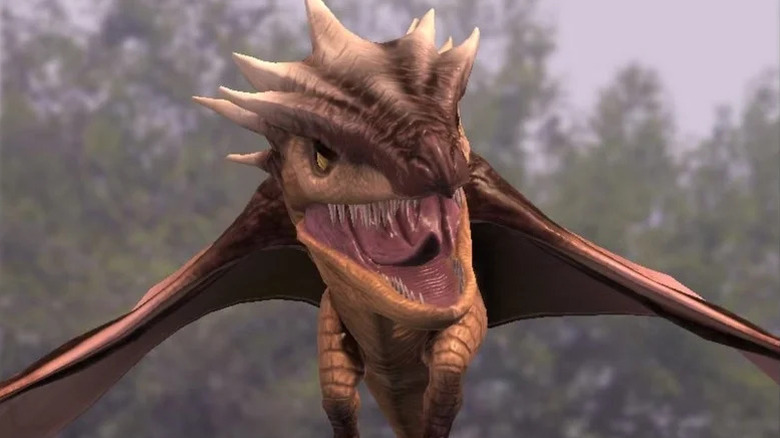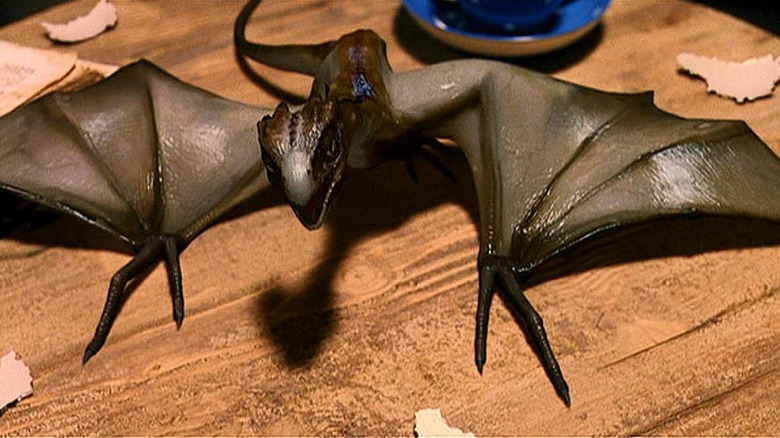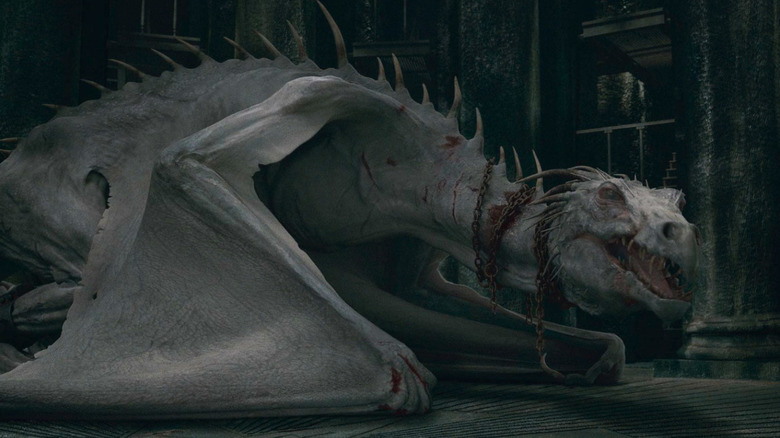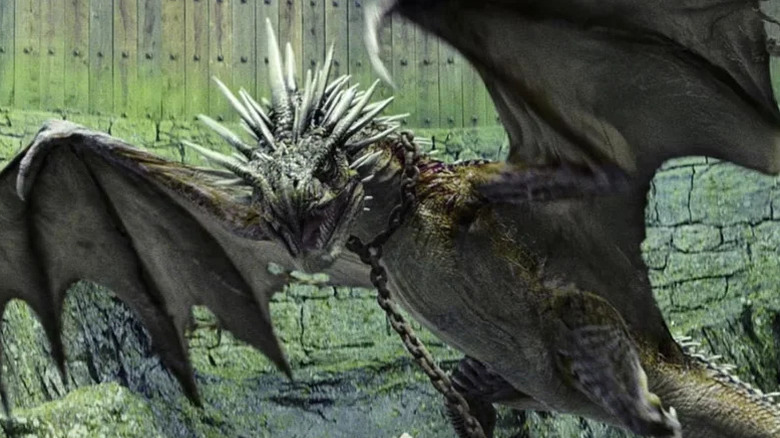All 10 Harry Potter Dragon Breeds Ranked
Whether it's the best-selling fantasy books or the blockbuster movie adaptations, the "Harry Potter" franchise is one of the most successful in the world. The coming-of-age adventures of teenage wizard Harry Potter and his friends feature plenty of mythical monsters, including dragons. As with many other fantasy depictions of these beasts, the dragons that Harry encounters are winged reptilian creatures that are quite formidable in their destructive capabilities. Novels and films like the prequel movie series "Fantastic Beasts" have expanded upon the dragons' presence in the wizarding world, making them a firm fixture in this realm of magic and monsters.
Of course, not all dragons are created equal, and there are a number of dragon breeds in the wizarding world. Varying in terms of their physical appearance, native region, and abilities, these creatures add variety to the extensive fauna that Harry crosses paths with. Though some of the "Harry Potter" supplemental text lists lesser dragons as also existing in this world, we're sticking with the ones specifically identified in the main series. With all of that in mind, here are all Harry Potter dragon breeds ranked based on their power and deadliness.
10. Antipodean Opaleye
Native to New Zealand, the Antipodean Opaleye are reputed to be among the most docile dragon breeds in the world, in contrast to their fiery counterparts. These dragons are also widely renowned for their beauty, possessing gorgeous pearly scales and multi-colored eyes with no irises. Dwelling in valleys rather than mountains, the Antipodean Opaleye only actively seek prey when they are hungry, preferring to hunt livestock and avoid human contact. The Opaleye can breathe fire, with the flame appearing bright red as it emerges from the dragon's maw.
The Antipodean Opaleye are not seen in the main "Harry Potter" novels or movies, nor are they mentioned by the characters therein. Instead, the dragon breed made its debut in the 2001 in-universe guidebook "Fantastic Beasts and Where to Find Them." Apart from video games, however, the Opaleye has not yet appeared on-screen in live-action, and, with "Fantastic Beasts 4" seemingly shelved, it's unlikely they will anytime soon. In the meantime, the Antipodean Opaleye exists as a majestic and relatively peaceful dragon that helps fill out the wizarding world in New Zealand.
9. Common Welsh Green
The Common Welsh Green are, as their name suggests, a dragon breed native to Wales, with the Ministry of Magic concealing their existence from Muggles (aka non-magical humans). Fortunately, most Common Welsh Green dragons prefer to prey on livestock and other small mammals, avoiding human contact if they can help it. That said, these dragons are fire-breathers, which does add to the danger that they potentially pose if they feel threatened. The book version of "Fantastic Beasts and Where to Find Them" lists a rare incident in 1932 when a Common Welsh Green attacked Muggles, which is outside of their usual behavior.
In the main novels, the Common Welsh Green appears as part of the Triwizard Tournament in "Harry Potter and the Goblet of Fire." In the first challenge, with participants tasked with retrieving a dragon egg, Fleur Delacour must steal an egg from a Common Welsh Green. This pits her against the least dangerous dragon in the challenge, with Fleur using a sleeping enchantment to lull the dragon into a slumber. Even sleeping, though, the Common Welsh Green offers an incendiary surprise, setting Fleur's skirt on fire with a snore, which she extinguishes with a water spell.
8. Hebridean Black
Anyone who's seen the "Harry Potter" movies has seen a Hebridean Black, or at least one's remains, likely without even knowing it. In "Harry Potter and the Chamber of Secrets" and "Harry Potter and the Prisoner of Azkaban," a Hebridean Black's skeleton hangs over the Defense Against the Dark Arts classroom. Native to the Hebrides islands off the coast of Scotland, the Hebridean Black dragons are darkly colored dragons with bat-like wings. Though more aggressive than the Common Welsh Green dragons, making them the most aggressive British dragons, the Hebridean Blacks prefer livestock as their primary prey.
While a living Hebridean Black doesn't appear in the main Harry Potter movies, the dragon is a staple of the video games. Most notably, it appears in the 2023 video game "Hogwarts Legacy," an open world "Harry Potter" game set in the 1800s. At the beginning of the game, the protagonist and Professor Eleazar Fig are attacked by a dragon while en route to Hogwarts. The dragon is revealed to be controlled by the villainous goblin Ranrok, and, although the player character and Professor Fig escape, their Ministry of Magic companion George Osric is killed.
7. Romanian Longhorn
As its name would suggest, the Romanian Longhorn is a green dragon native to the Carpathian Mountains in Romania. The creature is named for its long golden horns that protrude straight from its brow like a bull. These horns are used by the Romanian Longhorn to impale its prey, ideally positioning the hapless creature to be roasted by its fire breath before being devoured. In comparison to other dragons throughout the wizarding world, the Romanian Longhorns have a stouter and more muscular build than their more sinewy counterparts.
Despite being formidable creatures, the Romanian Longhorns' population plummeted due to poachers interested in hunting the dragons for their golden horns. In response, a large dragon preserve was established in Eastern Europe, allowing the dragon population to flourish under the observation and protection of wizards. Like several of the other dragons on this list, the Romanian Longhorn has yet to show up in any of the "Harry Potter" films. And outside of being introduced in the book "Fantastic Beasts and Where to Find Them," the Longhorn has only made a handful of token appearances in "Harry Potter" video games.
6. Swedish Short-Snout
Hailing from the mountains of northern Scandinavia, the Swedish Short-Snout possesses silvery scales and breathes a bright blue flame. This fiery breath is among the hottest from any dragon, capable of reducing organic matter, including sturdy lumber, to ash in a matter of seconds. Given its remote home, the Swedish Short-Snout doesn't encounter humans as often as its British or Romanian counterparts, reducing the overall number of attacks. That, of course, doesn't make them any less dangerous on the occasions in which they are encountered, especially in the movies and games.
In both the novel and film adaptation of "Harry Potter and the Goblet of Fire," Cedric Diggory steals an egg from a Swedish Short-Snout during the Triwizard Tournament. As the opening challenge, the moment is a sink-or-swim one for Robert Pattinson and the noble character he plays. Cedric tricks the dragon with a transfiguration spell, but this distraction is only temporarily effective, with the dragon returning its attention to him in time to give Cedric minor burns. Given how hot the Swedish Short-Snout's flame is reputed to be, Cedric Diggory got off easy — that time, anyway.
5. Chinese Fireball
Also known as the Liondragon, the Chinese Fireball gets its moniker from its country of origin and the fact that its fire breath is emitted in fireballs instead of a flaming stream. The Fireball is a bright crimson dragon armed with smooth scales, with its face also framed by protruding golden spikes. This breed of dragon is particularly fast and also possesses a natural cunning that makes it important not to underestimate. To add to its threat level, the Chinese Fireball has developed a taste for human flesh, making it much more likely to attack.
During the first challenge of the TriWizard Tournament, Viktor Krum is tasked with stealing a golden egg from a Chinese Fireball. Using a spell, Viktor temporarily blinds the beast, but, in its frenzied confusion, the dragon accidentally tramples the egg that Viktor needs. Given how deadly Chinese Fireballs can be, Viktor is lucky that he walked away from the encounter relatively unscathed. With that all being said, the next dragon breeds on this list are even more dangerous than the Fireball.
4. Peruvian Vipertooth
The smallest dragon breed in the wizarding world, the Peruvian Vipertooth, is also one of its most lethal. Native to the mountains on the eastern end of Peru, the Vipertooth grow to be about five meters long and have a coppery color to their scales. True to its name, there is a venom that's extremely poisonous to humans that coats the dragon's fangs. To make matters worse, Peruvian Vipertooth dragons have developed a strong affinity for consuming humans, making them all the more infamous within the wizarding community.
This notoriety was documented in the guidebook "Fantastic Beasts and Where to Find Them," with the Peruvian Vipertooth population growing dangerously difficult to control in the late 19th century. This led to organized hunts by wizards and witches to get the Vipertooth numbers to more manageable levels before they could seriously threaten the magical community and Muggles. As wizarding scientists began to study the Vipertooth, they discovered that they could contract a serious disease known as dragon pox from the creatures. Don't be fooled by their relatively smaller size, the Peruvian Vipertooth is an especially deadly dragon that has posed a historical threat to humans.
3. Norwegian Ridgeback
The Norwegian Ridgeback has the distinction of being the first dragon to appear in the entire "Harry Potter" franchise, both in the novels and movies. The Scandinavian dragon debuts in "Harry Potter and the Sorcerer's Stone" (or "Philosopher's Stone" if you're checking out the version for those in the U.K.). A mysterious dragon egg is gifted to Rubeus Hagrid, which turns out to be a Norwegian Ridgeback when it hatches. Even as an infant, the dragon displays a fire-breathing ability and a venomous bite in the novel that leaves Ron Weasley in need of urgent medical care.
Norwegian Ridgebacks grow to a much larger size as an adult, making their destructive capabilities all the more dangerous. An important character cut from the movies, dragon expert Charlie Weasley explains that female Ridgebacks are noticeably more aggressive than males, including towards humans. These dragons have darker scales and are indigenous to the northern mountains in Norway and other parts of Scandinavia but have flown as far south as the British Isles. While not directly targeting humans as often as Peruvians Vipertooth dragons, Norwegian Ridgebacks' larger size and strength definitely makes them formidable.
2. Ukrainian Ironbelly
The largest dragon in the wizarding world is the Ukrainian Ironbelly, which can weigh up to six tons and possesses a hide reputedly as strong as steel. What this dragon lacks in speed, it more than makes up for in sheer power, both in terms of physical strength and intensity of its fiery breath. Though originating from Eastern Europe, Ukrainian Ironbellies have spread westward, with the British Ministry of Magic occasionally becoming involved. In the movie "Fantastic Beasts and Where to Find Them," Newt Scamander (Eddie Redmayne) notes that Ironbellies were used as part of the wizarding air force during World War I.
This utilitarian deployment of Ukrainian Ironbellies spread to Gringotts Wizard Bank, which used an Ironbelly to guard its deepest and most valuable vaults. When raiding the bank in "Harry Potter and the Deathly Hollows," Harry and his friends use the dragon to break free from the subterranean vaults, freeing it in the process. This sequence is revisited in the amazing "Harry Potter and the Escape from Gringotts" ride at Universal Studios in Orlando. From flying over European battlefields to guarding the most exclusive bank vaults in the world, the Ukrainian Ironbelly has developed a fierce reputation.
1. Hungarian Horntail
Notoriously reputed as the most dangerous dragon in the world, the Hungarian Horntail is one of the beasts that appears most prominently in the "Harry Potter" movies. A dazzling blend of speed, strength, and sheer destructive power, the Horntails are regarded warily by even seasoned experts Charlie Weasley and Rubeus Hagrid. With a strong hide, long body, and a fiery breath that can extend over 20 feet, the Horntails are a pure force of nature. Velocity-wise, the Horntail is depicted as being able to keep up with a Firebolt broomstick, which can reach speeds of 150 miles per hour, making them literal speed demons.
In "Harry Potter and the Goblet of Fire," when Harry is mysteriously entered in the Triwizard Tournament, the first challenge pits him against a Hungarian Horntail. It's only through Harry's absolute mastery of flying at high speeds on his broomstick that he's able to outmaneuver the Horntail and steal its golden egg. Horntails have also appeared in a number of "Harry Potter" video games and are always a formidable sight when they make their presence known. Representing the apex of dragons' lethal qualities in the wizarding world, the Hungarian Horntail is the greatest dragon breed in the "Harry Potter" franchise.
